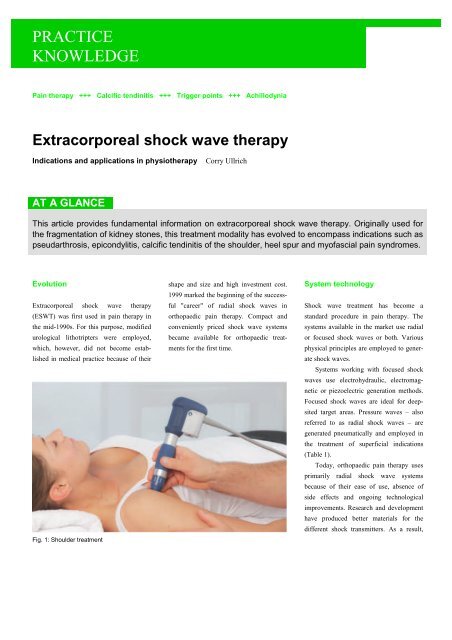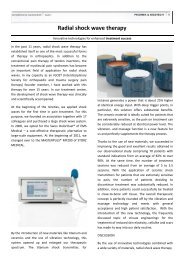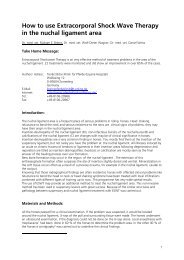Extracorporeal shock wave therapy - Shockwave France
Extracorporeal shock wave therapy - Shockwave France
Extracorporeal shock wave therapy - Shockwave France
Create successful ePaper yourself
Turn your PDF publications into a flip-book with our unique Google optimized e-Paper software.
PRACTICE<br />
KNOWLEDGE<br />
Pain <strong>therapy</strong> +++ Calcific tendinitis +++ Trigger points +++ Achillodynia<br />
<strong>Extracorporeal</strong> <strong>shock</strong> <strong>wave</strong> <strong>therapy</strong><br />
Indications and applications in physio<strong>therapy</strong><br />
Corry Ullrich<br />
AT A GLANCE<br />
This article provides fundamental information on extracorporeal <strong>shock</strong> <strong>wave</strong> <strong>therapy</strong>. Originally used for<br />
the fragmentation of kidney stones, this treatment modality has evolved to encompass indications such as<br />
pseudarthrosis, epicondylitis, calcific tendinitis of the shoulder, heel spur and myofascial pain syndromes.<br />
Evolution<br />
<strong>Extracorporeal</strong> <strong>shock</strong> <strong>wave</strong> <strong>therapy</strong><br />
(ESWT) was first used in pain <strong>therapy</strong> in<br />
the mid-1990s. For this purpose, modified<br />
urological lithotripters were employed,<br />
which, however, did not become established<br />
in medical practice because of their<br />
Fig. 1: Shoulder treatment<br />
shape and size and high investment cost.<br />
1999 marked the beginning of the successful<br />
"career" of radial <strong>shock</strong> <strong>wave</strong>s in<br />
orthopaedic pain <strong>therapy</strong>. Compact and<br />
conveniently priced <strong>shock</strong> <strong>wave</strong> systems<br />
became available for orthopaedic treatments<br />
for the first time.<br />
System technology<br />
Shock <strong>wave</strong> treatment has become a<br />
standard procedure in pain <strong>therapy</strong>. The<br />
systems available in the market use radial<br />
or focused <strong>shock</strong> <strong>wave</strong>s or both. Various<br />
physical principles are employed to generate<br />
<strong>shock</strong> <strong>wave</strong>s.<br />
Systems working with focused <strong>shock</strong><br />
<strong>wave</strong>s use electrohydraulic, electromagnetic<br />
or piezoelectric generation methods.<br />
Focused <strong>shock</strong> <strong>wave</strong>s are ideal for deepsited<br />
target areas. Pressure <strong>wave</strong>s – also<br />
referred to as radial <strong>shock</strong> <strong>wave</strong>s – are<br />
generated pneumatically and employed in<br />
the treatment of superficial indications<br />
(Table 1).<br />
Today, orthopaedic pain <strong>therapy</strong> uses<br />
primarily radial <strong>shock</strong> <strong>wave</strong> systems<br />
because of their ease of use, absence of<br />
side effects and ongoing technological<br />
improvements. Research and development<br />
have produced better materials for the<br />
different <strong>shock</strong> transmitters. As a result,
KNOWLEDGE<br />
Table 1: Major differences between <strong>shock</strong> <strong>wave</strong>s and pressure <strong>wave</strong>s<br />
Shock <strong>wave</strong><br />
Pressure <strong>wave</strong><br />
Pressure 100 – 1000 bar 1 – 10 bar<br />
Advertisement<br />
1/3<br />
Pulse duration 0.2 s 0.2 – 0.5 ms<br />
Pressure field focused radial, divergent<br />
Penetration depth high low, superficial<br />
Effect on cells tissue<br />
the range of applications was greatly extended<br />
over time and the treatment became<br />
much more comfortable for patients. Depending<br />
on the <strong>shock</strong> transmitter employed,<br />
radial <strong>shock</strong> <strong>wave</strong>s may reach a<br />
depth of up to 60 mm.<br />
syndrome, patellar tendinitis and trochanter<br />
tendinopathy. Further indications<br />
are trigger points, irritated tendons, irritated<br />
tendon insertions and myofascial pain<br />
syndromes (3).<br />
Guidelines and indications<br />
Study results<br />
The evolution of <strong>shock</strong> <strong>wave</strong> <strong>therapy</strong> has,<br />
of course, been strongly influenced by user<br />
experience and its consistent translation<br />
into technological solutions. Over the<br />
years, scientific studies have confirmed<br />
previous field reports. The <strong>therapy</strong> approach<br />
has undergone rapid progress and<br />
improvement over the last 12 years (1).<br />
In order to maximise treatment safety<br />
and standardise the procedure, DIGEST<br />
e. V. (German-speaking International<br />
Society for <strong>Extracorporeal</strong> Shock<strong>wave</strong><br />
Therapy) has established guidelines for<br />
<strong>shock</strong> <strong>wave</strong> <strong>therapy</strong> (2).<br />
The ISMST (International Society for<br />
Medical Shock<strong>wave</strong> Treatment) has published<br />
a list of clinically tested indications<br />
on its website. These include calcific<br />
tendinitis, including shoulder tendinitis<br />
(Fig. 1), lateral and radial epicondylitis,<br />
heel spur, achillodynia, tibial stress<br />
Treatment<br />
Two-step procedure<br />
Shock <strong>wave</strong> treatment comprises two<br />
steps. The first step consists in the local<br />
treatment of muscles during which <strong>shock</strong><br />
<strong>wave</strong>s are applied to active trigger points<br />
or painful muscle spots with severe local<br />
pain. In the second step, large-area muscle<br />
treatment takes place. With this so-called<br />
muscle smoothing technique, <strong>shock</strong> <strong>wave</strong>s<br />
are applied in the direction of the muscle<br />
fibres, treating not only the painful muscle,<br />
but, if necessary, also its antagonist.<br />
Application<br />
Treatment success is dependent on the<br />
application pressure applied, on the <strong>shock</strong><br />
transmitter type used and on the treatment<br />
frequency. In general, patients undergo a<br />
total of six to eight <strong>therapy</strong> sessions,<br />
receiving no more than two sessions a<br />
week. When exposed to <strong>shock</strong> <strong>wave</strong> <strong>therapy</strong>,<br />
the patient's body responds to the<br />
physical stimuli by various >>>
KNOWLEDGE<br />
LEGAL SITUATION<br />
From a legal perspective, physiotherapists are allowed to perform <strong>shock</strong> <strong>wave</strong> treatment in the<br />
following cases:<br />
upon prescription for patients with private medical insurance or upon prescription by a<br />
practitioner of alternative or complementary medicine;<br />
in their capacity as practitioners of alternative or complementary medicine;<br />
in their capacity as practitioners of alternative or complementary medicine specialising in<br />
physio<strong>therapy</strong><br />
Fig. 2: Treatment of a horse with a mobile<br />
<strong>shock</strong> <strong>wave</strong> system<br />
mechanisms. It is assumed that the body's<br />
direct reaction to reduce pain is to release<br />
«substance P» and increase metabolic<br />
activity.<br />
Effects<br />
Shock <strong>wave</strong>s have demonstrated to produce<br />
antibacterial and anti-inflammatory<br />
effects. Also, growth factors have been<br />
found in vessels, bones and connective<br />
tissue. Besides analgesic effects observed<br />
immediately during the <strong>therapy</strong>, <strong>shock</strong><br />
<strong>wave</strong>s primarily produce long-term results.<br />
Generally speaking, it can be said that the<br />
biological effects induced by <strong>shock</strong> <strong>wave</strong>s<br />
produce a time-shifted and sustained response<br />
inside the body. However, pain<br />
tolerance varies between patients, and they<br />
react differently to <strong>shock</strong> <strong>wave</strong> <strong>therapy</strong>. So<br />
accurate diagnostic examination and differential<br />
diagnosis are, of course, fundamental<br />
pillars of successful treatment (4).<br />
Radial <strong>shock</strong> <strong>wave</strong>s also play an increasingly<br />
important role in equine<br />
physio<strong>therapy</strong>. Here, they are used to treat<br />
muscle imbalance, tendon problems and<br />
chronic suspensory ligament conditions<br />
(Fig. 2).<br />
Other medical fields that use radial<br />
<strong>shock</strong> <strong>wave</strong>s include dermatology, cardiology,<br />
urology and aesthetic medicine.<br />
In Germany, <strong>shock</strong> <strong>wave</strong> <strong>therapy</strong> can<br />
only be provided upon medical prescription<br />
(see box).<br />
Cost-effectiveness<br />
A <strong>shock</strong> <strong>wave</strong> system requires a somewhat<br />
higher initial investment than other common<br />
medical devices used in physio<strong>therapy</strong>.<br />
This means that the question of<br />
cost-effectiveness is important to address.<br />
Depending on the type of system employed<br />
and on its accessories and performance<br />
parameters, the purchase price is<br />
between 10,000 and 18,000 euros. But<br />
what we should bear in mind is that a<br />
<strong>shock</strong> <strong>wave</strong> system is a capital good that<br />
helps to generate higher turnover.<br />
CORRY ULLRICH<br />
With a radial <strong>shock</strong> <strong>wave</strong> system, each<br />
treatment session is generally calculated at<br />
35 to 50 euros if one considers all costs<br />
incurred such as personnel, wear, time and<br />
fixed costs. So if one performs an average<br />
of one treatment a day on 220 working<br />
days a year and charges 50 euros per session,<br />
the annual turnover will be 11,000<br />
euros, which means the initial investment<br />
can pay off.<br />
FIGURES<br />
All figures in this article courtesy of STORZ<br />
MEDICAL AG.<br />
REFERENCES<br />
1) Dreisilker U., Book „Enthesiopathies“,<br />
Heilbronn, Level 10, 2010<br />
2) DIGEST e.V., (German-speaking<br />
International Society for <strong>Extracorporeal</strong><br />
Shock<strong>wave</strong> Therapy) www.digest-ev.de<br />
3) ISMST, International Society for Medical<br />
Shock<strong>wave</strong> Treatment www.ismst.com<br />
4) Gleitz M., Book „Myofascial Syndromes<br />
& Trigger Points“, Heilbronn, Level 10, 2011<br />
English translation of the original German<br />
article published in the October issue of<br />
pt_Zeitschrift für Physiotherapeuten-64<br />
[2012] www.physiotherapeuten.de<br />
Physiotherapist since 2005. Advanced training in MLD, sports<br />
physio<strong>therapy</strong> and Pilates. 2006 – 2009: dual system studies (combined<br />
vocational training and degree course) in economic sciences<br />
at DHBW (Duale Hochschule Baden-Württemberg, Germany) –<br />
Degree: Bachelor or Arts. Today member of the project management<br />
team of a Swiss manufacturer of extracorporeal <strong>shock</strong> <strong>wave</strong><br />
systems.<br />
Contact: ullrich.corry@storzmedical.com








